Latest Report: 2006
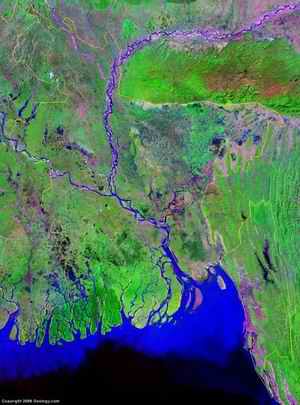
Latest Report: 2005
Latest Report: 2004
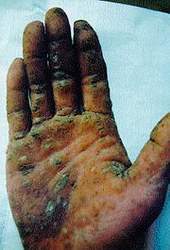 |
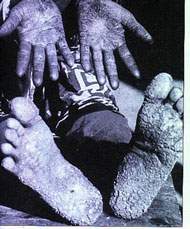 |
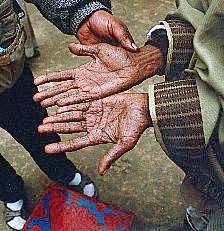 |
CONTENT:
REPORTS
- Thousands passing days amid arsenic panic in Meherpur, December 18, 2004
- Arsenic pollution in tubewell waters acute in Barisal December 15, 2004
- Japan assures of support- Project on cutting arsenic contamination of groundwater, November 29, 2004
- Is There No Salvation From Arsenic? October 20, 2004
- Arsenic levels in Barisal division alarming August 29, 2004
- Arsenic alarming in 195 Brahmanbaria villages , July 2004
- Arsenic Threatens 48,8,650 in Brahmanbaria District, Bangladesh
- In Gopalganj Water of 13,465 tube-wells arsenic contaminated, July, 2004
- 80 million people at arsenic risk, June 2004
- Effectiveness and reliability of arsenic Testing Kits : Are the million dollars screening Projects Effective or Not?
- Latest Report: November 2003
- Arsenic And Asia Development Bank Grant
- Critical Reports
- Acute drinking water crisis in Jessore
- On arsenic problems
- Arsenic in Bangladesh: Women suffer more from arsenic contamination in Bangladesh than men do
- Arsenic menace spreading its tentacles in Madaripur
- 7 Wards in CHittagong City
Arsenic level way beyond limit
35 million (3.5 crore) people facing arsenic contamination - Poor Mitigation ActivitiesAt least 3.5 crore people in the country are facing the threat of arsenic contamination, according to a survey conducted by the World Bank (WB) and the Water and Sanitation Programme (WSP). The WB and WSP released the survey report recently suggesting immediate measures against the menace. The government initiated a new scheme to scale up access to safe water in rural areas and small towns, incorporating stakeholders and providing quality service delivery under the Bangladesh Water Supply Project (BWSP). The access to safe water supply is the key element of Bangladesh Arsenic Mitigation Water Supply Project (BAMWSP), which was a pilot innovative measure to provide safe water free from arsenic and pathogens to rural areas and small towns. The BAMWSP has preferred to promote relatively non-controversial options, which include digging of wells, rainwater harvesting, pond sand filter, installation of deep tube-wells, household water treatment and community water treatment facilities among the arsenic-affected areas, sources added. Sources said about 50.70-lakh tube-wells have been screened under 270 upazilas in the country of which 14.4 lakh found contaminated by arsenic. The Department of Public Health Engineering (DPHE) has painted the arsenic contaminated tube wells with red colour and warned the villagers against drinking water from them. The DPHE has installed 739 wells in 24 upazilas, 12 pond sand filters in three upazilas, 2279 deep tube wells in 15 upazilas, 3001 rainwater harvesting plants in 20 villages and new labs for DPHE in two upazilas to supply arsenic-free water(The News Today, June 14, 2005) .
According to WHO the mean daily intake of arsenic through food by adults is in the range of 17-129 µg. Average arsenic concentration in rice grain produced in different parts of Bangladesh is 480 µg/kg. Considering average consumption of rice grain 454gm/capita/day average arsenic intake by a Bangladeshi people through only rice grain is 218 ug/day. A recent paper on cancer risk estimation in Bangladesh, on the basis of Taiwan data, showed that the lifetime risk of deaths from internal cancers among Bangladesh population would be more than double due to arsenic ingestion. In a several type of study scalp hair were collected from Daudkandhi and Begumgonj upazila of Bangladesh and analysed for arsenic. In this analysis arsenic concentrations were found in the range 8-13 ppm that is more than 4 times higher than the proposed NRCC (National Research Council of Canada) critical concentration of 2 ppm. Referring to adjusting data from the United States Environmental Protection Agency (EPA), it said that in Bangladesh with regards to projected future cases of arsenic related health burden, skin cancer would affect 375,000 people. The estimate also suggest that in Bangladesh 6,500 people will die from cancer every year and a total of 326,000 people in a period of 50 years, while 2.5 million people will develop some kind of arsenicosis over that period. So far, these two figures are the only quantification of the potential arsenic related health burden. They depend heavily on epidemiological assumptions and demonstrate how the lack of reliable epidemiology information adds uncertainties to the projected number of people at risk (The Bangladesh Observer, Magazine, June 24, 2005). |
Thousands passing days amid arsenic panic in Meherpur, December 18, 2004
40 pc people, 80 pc tubewells affected, 80 people died
Thousands of people in three upazilas of the district have been passing their days amid arsenic menace. The arsenic contamination has been detected in underground water of the district excessively. As many as 80 people died of arsenic related diseases of whom more than 30 at village Bholadanga under Gangni police station according to people. The Directorate of Public Engineering and the Health Department failed to give any data of the total number of people who have been suffering from arsenic related diseases, an unconfirmed survey report reval that 40 per cent people are suffering from the same. Meherpur is wasters district and bordering West Bengal, India has been identified as arsenic prone.
According to the sources of DPHE there were 35000 hand pump tubewells in the district up till last year. Out of the total some 1017 tubewells were tested by the DPHE and rest were examined by one Dhaka based Non-Government Organisation BAMS last year and found more than 80 per cent tubewells are more or less arsenic contaminated above 0.05 mg/1 in 40 per cent tubewell.
After being aware of deadly arsenic poisoning diseases crores of people in the country have been living in arsenic affected area. It may be stated that out of 65 districts 59 districts are arsenic affected of which perhaps Meherpur district in the highest arsenic invaded district. The people have been combating against arsenic curse. A group of journalists of various national dailies went to a remote village Bholadanga under Gangni Upazila of the district following a written information that more than 30 people had died of arsenic related diseases and as many as 500 people had been suffering from the deadly discase.
We found that the people were suffering from various skin disceses. Dr. Sajedur Rahman Medical Officer attacched to the civil surgeon office accompanying us said, most of the diseases are caused by arsenicosis. However, the people of village Bholadanga stopped drinking the water of the existing tubewells as the DPHE dug 95 ring-wells for arsenic-free drinking water which is considered very poor in number. Villagers consider the disease as the work of evil spirits. Many of the doctors are not well conversant about the arsenic poisoning and wrong treatment by them not only the causes untold sufferings to the patients but also it occasionally become fatal. The majority illiteratemen and women believe that disease is often caused by Allah on evil spirits they commotsin.
Government and the donor agencies have been spending crores of Taka - but no significant progress has been made
The government and the donor agencies have been spending crores of Taka for identifying contaminated tubewells and far safe drinking water but no significant progress has been made so for in the country and no effort has been taken to find out an alternative arrangement for safe drinking water. The arsenic mitigation program run by the government with the help of the donor agencies had a project to set up Community Tubewells free from arsenic contents in each village. But nothing had been done so far in this project according to an unconfirmed sources (The Bangladesh Observer, December 19, 2004)
Note: The same picture repeats all over the country
Back to Content Arsenic pollution in tubewell waters acute in Barisal December 15, 2004
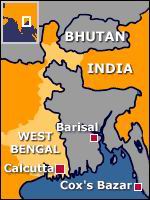 The Bangladesh Observer on Dec. 15, 2004 describes, "As the country is facing acute problem of arsenic pollution in tubewell waters, the people of the affected areas are searching for alternatives for safe drinking water."
The Bangladesh Observer on Dec. 15, 2004 describes, "As the country is facing acute problem of arsenic pollution in tubewell waters, the people of the affected areas are searching for alternatives for safe drinking water."
As a means of getting the safe water, the people of village Khalishpur under Bagerhat district are now collecting rainwater, storing and drinking it during the lean period of the year. With the help of a local NGO called Gano Milon Kendra (GMK), the villagers have installed four Rainwater Harvesting System (RWHS) plants having a capacity of storing 10,000 litres of water each at their homesteads.
Talking about the technical aspects of the RWHS plant, Mahin Akbar, Associate Programme Engineer of NGO Forum, said the plant for the community use is constructed under the ground to minimise the cost as well as to keep the water cool. He also informed that the technologies like RWHS plant and Pond Sand Filter (PSF) plant developed by NGO Forum are also being replicated in the arsenic affected areas of India. "An Indian organisation recently sough technical cooperation from the NGO Forum to install PSF and RWHS. Accordingly, two experts from the NGO Forum visited West Bengal in April and May this year," he added (The Bangladesh Observer, December 15, 2004)..
We hope that NGO Forum is not doing the same mistake as it did in Faridpur district.
NGO Forum's Failed Mitigation in Faridpur District
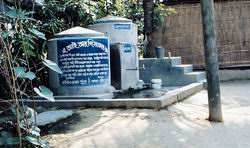 |
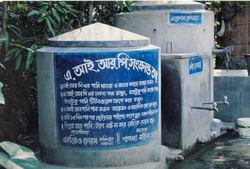 |
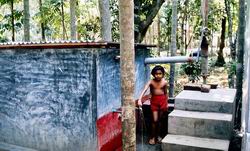 |
Multiple chemical requirement, operation requires a huge resource and technological training. High investment, high running cost,a high technical operation and maintenance make it impossible to reach arsenic free water for the mass population. NGO Forum responsible for Arsenic Mitigation advertising in Faridpur for Pond Sand Filter (PSF) but in practice it has become a garbage!
The Rain Water Harvesting unit constructed by the NGO Forum in Faridpur is not working from the first day. Most disturbing object is that these people who are using the sand filter never warned by the NGOs that the same poisonous water is pouring through their wells via filter.
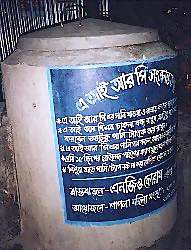 |
Arsenic Removal Filter from tube wells (Tubewell Sand Filter): A vertical column consisting of three chambers brick chips or iron chips, coarse sand, fine sand are the elements of Tubewell Sand Filter. This has been introduced by several NGOs and government orginisations. In Faridpur near Tulagram (left: picture) a TSF has been very recently constructed by NGO Forum. The villagers paid Tk.3000 and the total cost is about Tk. 50, 000/. We examined the water and found arsenic concentration 70 µg/l, in other words, it should be painted red.We saw that villagers were wasing brick chips, sands with pond water, in other words, contaminating with colio and other bacteria. We found several other filters (TSF) at Aliabad, Bakunda are abondoned.The NGO Forum maintains close collaboration with all relevant government agencies (DPHE, NIPSOM, LGED, etc.), Universities, UN bodies (UNICEF, World Bank, etc.), Donors, DPHE-DANIDA, BAMWSP, as well as other NGOs. The NGO Forum is playing a vital role in the Bangladesh Arsenic Mitigation Water Supply Project (BAMWSP) as a member of the steering committee as well as in project implementation including selection of Partner NGOs and CBOs for any area selected. What a misuse of money! |
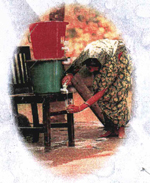 Two bucket filter to remove arsenic was introduced by Danish Aid and NGO Forum, DPHE. Danida introduced a year ago two bucket system replacing one poison to other. A huge amount of money has been spent to make this project a success. People have rejected this project. If you visit villages, you'll find villagers are using the buckets for using other purposes. If you ask villagers, they say, "First the water does not taste, colour of water becomes red and it is difficult to use the method!" It was never published how much tax payers money was spent! We could not find any single unit is in use. But NGO Forum office said that two bucket system is used in the villages! We did not spent any more time to visit here again. DPHE-DANIDA Arsenic Mitigation Pilot Project: A pilot project under DPHE-DANIDA has been taken up in the south-eastern part of Bangladesh. The estimated cost of the project is about Tk 70 7 057 000 (Tk 60= I US dollar). The project is designed for three years and a half (up to June’2004) and will be implemented in two phases.
Two bucket filter to remove arsenic was introduced by Danish Aid and NGO Forum, DPHE. Danida introduced a year ago two bucket system replacing one poison to other. A huge amount of money has been spent to make this project a success. People have rejected this project. If you visit villages, you'll find villagers are using the buckets for using other purposes. If you ask villagers, they say, "First the water does not taste, colour of water becomes red and it is difficult to use the method!" It was never published how much tax payers money was spent! We could not find any single unit is in use. But NGO Forum office said that two bucket system is used in the villages! We did not spent any more time to visit here again. DPHE-DANIDA Arsenic Mitigation Pilot Project: A pilot project under DPHE-DANIDA has been taken up in the south-eastern part of Bangladesh. The estimated cost of the project is about Tk 70 7 057 000 (Tk 60= I US dollar). The project is designed for three years and a half (up to June’2004) and will be implemented in two phases.
Failure of Danish Development Help
Tube Well Sand Filter (TSF) Financed by US AID, SIDA, Churches of Industrial countries etc, May 2004
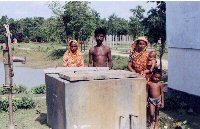 This was a good intention of the donors to give arsenic free water to the rural pupulation, but all the wells show a high content of arsenic. The filter elements are directed to be washed and cleaned every fortnight. The villagers wash in pond water and thus adding biological contamination. If they drink pond water, it is free from arsenic but contains biological, pesticide contamination. Arun Shiel of Murahidoha, Faridpur said, We have paid Tk. 3000, now you say that this water is not good. what shall we so? May, 2004"
This was a good intention of the donors to give arsenic free water to the rural pupulation, but all the wells show a high content of arsenic. The filter elements are directed to be washed and cleaned every fortnight. The villagers wash in pond water and thus adding biological contamination. If they drink pond water, it is free from arsenic but contains biological, pesticide contamination. Arun Shiel of Murahidoha, Faridpur said, We have paid Tk. 3000, now you say that this water is not good. what shall we so? May, 2004"
In principle coagulation and filtration process work only with trained operator by public water supply. US EPA (1999) comments that coagulation and filtration is not appropriate for most small systems - high cost, need for well trained operaton variability in process performence. The main drawbacks of this type of treatment are the poor As (III) removal and the problem of the disposal of the toxic sludge produced which can contain high concentration of arsenic.
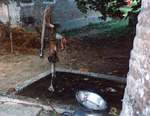 A Pond Sand Filter (inclusive renovation of the pond ) costs about 150 000 thousands Taka (1 US Dollar= 60 Taka). Paradox is that close to the pond there is a tubewell painted green that contain arsenic far below the standard. It was not necessary to make an expensive PSF here. NGO Forum needs basic knowledge on project implementation! When we asked for a project report at NGO Forum office in Faridpur, they said, "We just distribute the project to other NGOs."Officers were not friendly to us!
A Pond Sand Filter (inclusive renovation of the pond ) costs about 150 000 thousands Taka (1 US Dollar= 60 Taka). Paradox is that close to the pond there is a tubewell painted green that contain arsenic far below the standard. It was not necessary to make an expensive PSF here. NGO Forum needs basic knowledge on project implementation! When we asked for a project report at NGO Forum office in Faridpur, they said, "We just distribute the project to other NGOs."Officers were not friendly to us!
| NGO Forum "The NGO Forum maintains close collaboration with all relevant government agencies (DPHE, NIPSOM, LGED, etc.), Universities, UN bodies (UNICEF, World Bank, etc.), Donors, DPHE-DANIDA, BAMWSP, as well as other NGOs. It has established an Arsenic Cell as well as undertaking water quality testing, and shares all its findings of interventions at field level with all stakeholders. It is extending cooperation to others at field level for identifying patients with arsenicosis and for testing water samples The NGO Forum has developed and produced two posters and two leaflets on arsenic contamination in consultation with the communication and arsenic experts of different agencies" From NGO Forum Web. We have not seen any successful mitigation event in Faridpur district, one of the most arsenic affected areas of Bangladesh. We wanted have poster and booklet at NGO Forum office but we have to pay about Tk. 300 (six days salary of a woman worker in Faridpur). Is it possible for the poor to buy such information? When we pointed out that they have many wrong results, specially one that we determined a high arsenic concentration (300 µg/l) at North Alipur but their representative certified to be of best quality. The NGO Forum Chief replied, "They give training, equipment and chemicals to their representative organisations, and not responsible for results." |
Arsenic Removal Plants that we have examined in Bangladesh are not funtioning and producesarsenic contaminated water above standard. Unfortunately, people are not informed!
Back to Content Japan assures of support- Project on cutting arsenic contamination of groundwater; November 29, 2004
Expressing grave concern at the contamination of groundwater, LGRD and Cooperatives Minister Abdul Mannan Bhiuyan yesterday said that about 30 per cent of the country’s shallow tubewells have been reported to be contaminated by arsenic, posing a great threat to supply of fresh drinking water, particularly in rural areas of the country.
He was speaking as chief guest at the final seminar on a project titled ‘Integrated Approach for Mitigation of Arsenic Contamination of Drinking Water in Bangladesh’ at a local hotel in the city yesterday. The project is jointly conducted by Japan International Cooperation Agency (JICA) and Asian Arsenic Network (AAN). JICA and AAN in collaboration with the LGRD and Cooperatives Ministry organised the seminar. AAN under a partnership programme with JICA has started implementing the three-year project with assistance from the LGRD and Cooperatives Ministry of Bangladesh. The project is being implemented in Sharsha upazila of Jessore district since January 2002 and will be completed by December this year.
Japanese Ambassador to Bangladesh Matsushiro Horiguchi was present at the function, while among others, LGRD and Cooperatives Joint Secretary Mokhlesur Rahaman, JICA Resident Representative Akio Arai, JICA/AAN Arsenic Mitigation Project Manager Kazuyuki Kawahara, Project Director of Strengthening Water Examination System Amanullah Al-Mahmood spoke. Quoting from a report of a survey which was conducted by the LGRD and Cooperatives Ministry, Abdul Mannan Bhuiyan said 271 upazilas of the country have been affected by arsenic-related disease, and the ministry has taken initiatives to mitigate the arsenic contamination of those upazilas in collaboration with international development partners. "In this regard, the government also has approved the National Policy for Arsenic Mitigation and "Action Plan," he added (The Independent, November 29, 2004).
Is There No Salvation From Arsenic? October 20, 2004
The arsenic contamination found in the ground water is, as we know, detrimental to the health of the people its presence in the ground water of Bangladesh has long been established and today, village after village has been affected. As has been repeatedly demonstrated, there is still considerable confusion over the causes of this contamination and even more confusion over possible cures and preventive measures. In fact there seems to be more politics in the situation than arsenic and though indifference is not surprising among government agencies and officials, it is a matter of grave concern that the UN agencies trying to help, are subjected to active criticism.
For example, at a meeting of Asian environmental journalists in 1999 held at Comilla, a senior Bangladeshi government health officer reportedly claimed his country was "a victim of UNICEF aggression." and though we would not go so far as to call it, as he apparently did, a case of "criminal negligence," we do question why, when it was known to UN agencies in India that ground water in West Bengal was contaminated, they did not pass on this information to their counterparts in Dhaka. Although Bangladeshi journalists have been charged with repeating sensational allegations without checking the facts, had they not raised these issues, the World Bank would not have been brought in to help us. Because no matter what, the harsh truth is that some 80 million Bangladeshis have been drinking water containing arsenic that is sometimes a hundred times above the safety level.
Many people have been crippled or dying from cancer, therefore if people in this wretchedly poor country are still drinking arsenic-poisoned groundwater, it is a serious indictment on our ability to cope. Unless we improve our ability to home in on that poisoned well in their vicinity or inform people of the quality of the water they are drinking many more will be equally crippled. Reports tell us that girls cannot get married unless villagers parade them before prospective bridegrooms to show there was nothing unique about the lesions on the girl’s body. How more demeaning can that be?
Why arsenic has been found in the groundwater is still an unanswered question, and it may never be answered because scientists who have studied for so long are still unable to agree on the causes although they do accept that arsenic is natural and found in this region because it came with the silt deposited by the mighty rivers centuries ago. But the issue of why this natural arsenic is activated in the groundwater is still a matter of theory.
The issue of arsenic and agriculture is also not receiving the attention it should. Thousands of shallow tube wells are pumping millions of gallons ground water with high arsenic content for irrigation and as during the coming winter season rice and wheat crops will depend on irrigation water, we can only imagine how much arsenic (thousands of tons) will be dumped on the crop fields.
Dr Zuberi of Rajshahi University reported that he and other scientists detected significant inhibitory effects of arsenic contaminated tube well water (ca 150 and 450 ppb) on seed germination, seedling growth and yield on four Rabi crops in their laboratory. This is alarming. The overwhelming need is for scientists, experts and government agencies to come to an understanding of how the poisoning has occurred, so that proper mitigation measures can be taken without controversy. In other words, ultimately all monitoring must lead to an answer as to why people are suffering, and what we must do about it (Editorial, The Bangladesh Observer, October 20, 2004)
Back to ContentArsenic levels in Barisal division alarming August 29, 2004
Disease and maladies in Bangladesh have reached such an extent that the cumulative number of the affected has exceeded the total number of the population, according to compiled data provided by health experts and the government in 2003. More than 70 million people are infected with tuberculosis and 4 million with diabetes, 7 million suffer from asthma and an equal number from chronic obstructive lung diseases, 10 million have kidney diseases, over 10 million carry the thal assaemia gene and over 80 million people are at risk of arsenic poisoning. An estimated 37 per cent of the population suffer from heart diseases and 10 per cent from some sort of hearing impairment. Diarrhoea is responsible for 21 per cent of child deaths and pneumonia and other infectious diseases claim the rest.
More than over 250,000 children die every year before they are one year old. Five to six thousand children develop cancer and the country is on the verge of an HIV epidemic. If the data provided by experts and the government are correct, this is where the country's health, or lack thereof, stands. Tuberculosis is still the major killer disease. Government estimates say 50 to 60 per cent of the population are infected with tuberculosis. Nearly 300,000 new individuals contract the disease and 70,000 die every year.
The National Tuberculosis Control Programme has an annual target of detecting of 70 per cent of the infectious cases but manages only 34 per cent on average. The rate of cure has been 84 per cent among detected cases against a target of 85 per cent. Mass poisoning with arsenic remains at catastrophic levels. Groundwater of 60 of 64 districts is considered affected, rendering over 80 million people at risk of chronic arsenic poisoning. Arsenic contamination of the food chain though groundwater irrigation is a newly discovered health threat.
Over seven million people suffer asthma, an allergic respiratory disease, and 4 million of them are children, said speakers at a national conference on allergy and immunology in March 2004. Environmental pollution, use of newer drugs, rampant adulteration and use of artificial flavour agents in food have been added recently to the list of already-blamed allergens like dust, flower grains and certain food. The health and family welfare minister said while speaking as chief guest at the inaugural ceremony of the conference that about 200,000 people develop allergic reactions every year after taking newly-marketed drugs.
The WHO also estimates that 9 million people suffer some sort of hearing impairment, a majority of which (over 50 per cent) are because of infections and thus preventable. About 8,000 estimated snakebites occur in the country with a mortality rate of more than 20 per cent.
A population-based surveillance by the International Centre for Diarrhoeal Diseases Research, Bangladesh in a rural community in southwest Bangladesh revealed that mortality in suicide is 39.6 per 100,000 people, which translates to more than 500,000 deaths per year if the incidence is assumed to be homogenous. Though the mortality rate has been reduced over the past two decades, diarrhoeal diseases still account for 21 per cent of all child deaths in the country and contribute a big number to the 2.5 million deaths per year of children aged less than 5 years in developing countries.
Respiratory infections claim uncounted numbers of deaths every year. Kala-azar has also re-emerged. Malaria claimed over 500 deaths in 2003. Nipah encephalitis emerged as a new threat to public health last January and dengue stuck the country for the fifth successive year this year. An estimated 13,000 HIV patients reside in the country which is on the verge of facing an epidemic outbreak of the killer disease due to heightened risk factors and risky behaviours (New Age, October 9, 2004).
Back to ContentArsenic levels in Barisal division alarming August 29, 2004
Even water of deep tubewell is contaminated with the deadly poison at places, according a recent survey jointly done by the NGO Forum and the Dhaka Community Hospital. Of the dead, 22 are in Barisal Sadar, eight in Babuganj and two in Agailjhara upazilas in the district. The survey identified 334 arsenicosis patients only in Babuganj upazila. Conditions in the Sadar, Hizla and Muladi upazilas are similar, it said Water of most of the shallow tube wells in the areas is contaminated with arsenic, which has affected a large number of people in different areas of the district. Conditions in Bhola and Patuakhali districts are no better. Arsenic has also been found in at least 24 deep tube wells in Barisal division-- 18 of those in Barisal, five in Bhola and one in Pirojpur. All shallow tube wells are arsenic- contaminated in 200 villages in 40 upazilas in Barisal division, the survey revealed. Presence of arsenic is "alarmingly high" in some of the shallow tube wells. According to statistics, there are 16, 776 deep and 50,153 shallow tube wells in ten upazilas of Barisal district. These were sunk by the Department of Public Health and Engineering (DPHE), different NGOs and by private users to ensure safe drinking water. The deep tube wells found contaminated include those at Shahid Zia College in Nazirpur; Proshika office in Sahakati; Mahmudia Madrasha and Koira High School in Charbaria in Barisal Sadar upazila and at several houses in Uzirpur and Babuganj upazilas. Arsenic has also been found beyond the permissible level in some of the deep tube wells sunk in Gazaria, Daulatkhan and Chafession upazilas in Bhola district. Once people were motivated by NGOs and different government agencies to use groundwater for safety. People are confused now as they are advised to use surface water again (Daily Star, August 29, 2004). |
1. Arsenic alarming in 195 Brahmanbaria villages - 154 arsenicosis patients identified, July 2004
Arsenic contamination of groundwater is alarming in Nabinagar upazila where all 196 villages except one are affected. The lucky village is Rasulpur in Natghar union. In 58 of the villages, there is no tube well free from arsenic.
The serious contamination is now a health hazard, with 154 people suffering from arsenicosis, a virtually incurable silent killer disease, according to the Department of Public Health Engineering (DPHE), Brahmanbaria. But health officials in other government departments claim that the number of arsenicosis patients is 216. The number is increasing, they said. Arsenic damages kidney, liver, skin and nerves system and leads to death gradually.
The DPHE in a recent survey found that 23663 out of 28068 tube wells in the upazila are contaminated with high percentage of arsenic. The survey identified 34 villages as worst affected. DPHE field officials have marked the affected tube wells with red colour and asked people not to use those. But finding no alternative, people are drinking arsenic contaminated water from red-marked tube wells.
 Meanwhile, trade on arsenic-free water has become a booming business in view of the crisis of pure drinking water.
A trade association--Ashar Alo Bebosaye Samati--has set up a treatment plant at Nabinagar upazila headquarter and selling 6000 letres of water a day at the rate of Tk 5 per bucket. But this is too inadequate to the demand.
Booming trade in water... Arsenic-free water purchased at Tk 5 per Jerrycan is being taken from the treatment plant at Nabinagar upazila headquarter (Daily Star, July 20, 2004).
Meanwhile, trade on arsenic-free water has become a booming business in view of the crisis of pure drinking water.
A trade association--Ashar Alo Bebosaye Samati--has set up a treatment plant at Nabinagar upazila headquarter and selling 6000 letres of water a day at the rate of Tk 5 per bucket. But this is too inadequate to the demand.
Booming trade in water... Arsenic-free water purchased at Tk 5 per Jerrycan is being taken from the treatment plant at Nabinagar upazila headquarter (Daily Star, July 20, 2004).
1. 1. Arsenic Threatens 48,8,650 in Brahmanbaria District, Bangladesh
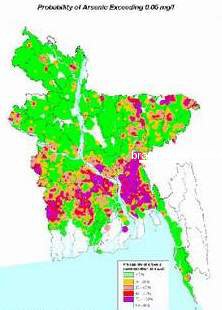 Two hundred and sixteen persons were affected with arsenic-related diseases in Nabinagar upazila.
This is because of consumption of arsenic contaminated water. Water of 23,663 tube wells in 195 villages were detected to be arsenic contaminated.
Two hundred and sixteen persons were affected with arsenic-related diseases in Nabinagar upazila.
This is because of consumption of arsenic contaminated water. Water of 23,663 tube wells in 195 villages were detected to be arsenic contaminated.
Water of all tube-wells in 34 villages of the upazila are highly contaminated with arsenic.
The most severely-affected villages are: Chander Char, Das Kanda, Sadekpur, Daponia, Islampur, Kamalpur, Lakhawra, Radhanagor, Bangaura North, Asrabpur, Pandabnagar, Padmanagor, Bhatpukur, Kajzlla, Barashikonika, Chalikhula, Chakrakhukla, Buldibari, Gunpukuria, Bajebishara, Piara Kandi, Char Manik Kandi, Dawlathpur, Kazirgong, Sampur, Kazimabad, Damkandi, Manipur, Nandua, Badruksa Bari, Bandukhar, Nasrabari, Ghiara and Rasulpur.
Water in all tube-wells of 58 villages are not worth consumption.There are 48,8,650 people in 195 arsenic affected villages. They are living in a very vulnerable situation. The Department of Public Health Engineering (DPHE), Brahmanbaria district conducted a survey and examined all 28,068 tube-wells and found water of 23, 663 tube wells were highly contaminated with arsenic. About 1,518 tubewells were completely out of order. The DPHE also detected 154 arsenic patients there.
The DPHE staffers marked red the arsenic contaminated tube-wells so that none consumes water of the tube-wells.
But as there was no alternative, people were found to drink arsenic-contaminated water from the red-marked tube-wells. Even people used to drink water of the Titas river and other ponds. As a result, more than 300 people were attacked with diarrhoea and other water-borne diseases, local people and hospital sources said.
While this correspondent visited the spots, Abdul Kadir of Biddaya Kut Village told him that they were suffering from arsenic pollution for more than three years. But the authorities did not take step to mitigate their sufferings (Staff Reporter, The Daily Star, January 22, 2004).
Back to Content
2. In Gopalganj Water of 13,465 tube-wells arsenic contaminated
Arsenic has created panic in three upazilas of Gopalganj district. Arsenic has been detected in water of 13,465 out of 15,207 tube-wells in Muksudpur, Kasiani and Gopalganj Sadar upazilas, In Sadar upazila, 311 arsenic affected patients have been detected and at Chandradighalia village of Paikkandi union parishad (UP), 91 patients have been detected. As many as 3,38,990 members of 47,934 families in 211 villages were examined.
Most of the tube-wells in the affected areas have been sealed off by marking red and with a warning signboard by the Department of Public Health Engineering Department (DPHE), Gopalganj. A survey was also conducted by an NGO, Gano Unnaya Prochesta (GUP) in 22 unions of Sadar upazila from April 1 to June 30, 2004 (Daily Star, July 11, 2004)
Back to Content3. 80 million people at arsenic risk
80m people at arsenic risk Bhuiyan (Minister in charge Arsenic Mitigation) tells parliament UNB, Dhaka, June 14, 2004:
Some 80 million people in 59 districts are at arsenic risk, but not in vulnerable state, LGRD Minister Abdul Mannan Bhuiyan told parliament yesterday. Replying to Md Amzad Hossain Sarkar, he said to face the arsenic threat the government recently had approved "Bangladesh Arsenic Policy 2004" and "Mitigation Plan." The minister said it would help tackle the problem of the chemical poisoning of groundwater.
"Under this policy steps have been taken to supply safe water in different parts of the country," he told the House. The government, giving top priority to solving the problem, is implementing 14 projects to provide safe water to arsenic-prone areas.
In reply to a question from Rowshan Ershad, he said that to provide safe drinking water in rural areas under GOB-4 project,
There are 68,000 thousands villages in Bangladesh. Most of LGRD Ministry's present targets have failed to solve arsenic prbleme. For example PSF (Pond Sand Filter), deep tube wells and tara pump (dangerous for children) etc. have failed.If Government intends to set deep tubewells
It is painful to see wastage of money of the taxpayers. PSF (Pond Sand Filter) has been rejected by the rural population as it does not work and most of the ponds are contaminated with biological and chemical contaminants. Deep tubewells are wrongly constructed, and even where it is not necessary (We have shown at places where deep tube wells pour saline and arsenic contaminated water, but we found low cost arsenic free (below standard) aquifers at the same place. Dug wells can not be constructed every where, maintainance of dug wells is a probleme. Holocene geology is not known to LGRD Ministry. There is any lithostratigrahic map exists in bangladesh. Without knowing ground water geology any attempt to mitigate arsenic will be a failure as in the past
Governments (we have had three, including the present, since arsenic in tubewells became known) and the donors and development agencies have wasted nearly a decade, first trying to trivialise it, then suppressing the fact and lately waking up, albeit slowly. But we are still far from a well-thought-out national policy that can address all the aspects of the tragedy (Editorial, The Bangladesh Observer 16. 01. 02.)
We fail to understand why a comprehensive mitigation programme has not been achieved since almost all concerned have admitted that it is a serious threat to human lives.
To my knowledge, till date it's really very difficult to get valid information from most of the organisations. A large proportion of the organisations /individuals think that data are their property and shouldn't be shared with others. They don't even document their works and information in the form of report or publish the information in any journal (The Daily Star,11. 01. 02) .Till today September 3, 2003) the attitude has not been changed.
Our project proposals have been rejected by the Ministry of Local Government and Resource Development and Ministry of Health, responsible for health and mitigation although it was a fraction of the money they spent.
We wish that mitigation becomes successful. But difficult to believe as it continues to be the same.
Back to Content4. Effectiveness and reliability of arsenic Testing Kits : Are the million dollars screening Projects Effective or Not?
Stakeholders of arsenic mitigationin Bangladesh and India reports: "Effectiveness and Reliability of Arsenic Field Testing Kits: Million Dollar Screening Projects Effective or Not."
| The exposure of millions to arsenic contaminated water from hand tube wells is a major concern in many Asiatic countries. Field kits are currently used to classify tube wells as delivering arsenic below 50 µg/L (the recommended limit in developing countries) as safe, painted green or above 50 Ěg/L, unsafe and painted red. More than 1.3 million tube wells in Bangladesh alone have been tested by field kits. A few million U.S. dollars have already been spent and millions are waiting for the ongoing projects. However, the reliability of the data generated through field kits is now being questioned. Samples from 290 wells were tested by field kits and by a reliable laboratory technique to ascertain the reliability of field kits. False negatives were as high as 68% and false positives up to 35%. A statistical analysis of data from 240 and 394 other wells yielded similar rates. We then analyzed 2866 samples from previously labeled wells and found 44.9% mislabeling in the lower range (<50 Ěg/L) although mislabeling was considerably reduced in the higher range. Variation of analytical results due to analysts and replicates were pointed out adopting analysis of variance (ANOVA) technique. Millions of dollars are being spent without scientific validation of the field kit method. Facts and figures demand improved, environmentally friendly laboratory techniques to produce reliable data. Dipankar Chakraborti, Mohammad Mahmudur Rahman, Debapriyo Mukherjee, Mrinal Kumar Sengupta, Uttam Kumar Chowdhury, Dilip Lodh, Bhajan Kumar Biswas, Chitta Ranjan Chanda, Shibtosh Roy, Md. Selim, Quazi Quamruzzaman, Abul Hasnat Milton, S. M. Shahidullah, Md. Tofizur Rahman. |
Majority of the test kits used in Bangladesh are based on the Gutzeit method which involves the reduction of of As(III) and As(V) by zinc to give arsine gas which is then used to produce a stain on mercuric bromide paper. Most of the projects used Merck arsenic test kits (Made in Germany). But it has limitation. Merck Kit gives reliable result but humidity (above 90%) and temperature (above 25şC) make the chemical inactive after two weeks use. But average temperature in Bangladesh and India (W. Bengal) is about 30şC. Temperature can be regulated with cool box but not the humidity. We have not seen any NGO took any protective measures.
Final Project Report - Arsenic Test
But so far we have seen only a proliferation of NGOs, assorted consultants, bottled water and filter sellers and what not, catching larks, so to say, while the poisoning continues (Editorial, The Bangladesh Observer, Januyry 16, 2001).
So far it surprises us, we do not see any published project reports.
Back to Content4. Latest Report: November 2003
 |
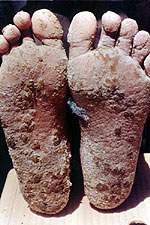 |
 |
During rainy season we do not hear about the suffering of the rural population. It is surprising to see that as soon as winter months approches, conferences, workshops and arrival of foreign experts make it thinking, as if, everything will turn to a good end. Promises, concepts and advises rise in the atmosphere. Air conditioned transport brings the experts to some selected areas. Villagers think something postive will happen now. But this they have seen since last ten years. The present Government, or the past Government has failed to mitigate arsenic contamination. So it will be the same with the future Government. Is there any hope?
Prof. Iqbal Zuberi, Rajshai University writes (November 3, 2003):
Yes, people are drinking as usual from contaminated tube- wells; nothing is happening; I am not visiting these villages where I used to go because I can do very little for them. They do not want words, they are not willing to take initiatives; you have to provide them with the solution. I do not have the solution. I can work with them, help them but have no means to give them the support needed. The two wells in Bogra village are by the DPHE /Local Government; one is close to a polluted pond and the water smells; these can not be dug deep bacause of sandy soil.
The World Bank formulated the following arsenic mitigation project for Bangadesh:
Bangladesh-Mitigation of Arsenic in Groundwater
World Bank Project No: BDPE50745:
Implementing Agencies:Government of Bangladesh (GOB)Ministry of Local Government and Rural Development, Dhaka, Bangladesh Project Objectives: The project aims to alleviate Arsenic contamination as a factor in the reduction of arsenic-induced mortality and morbidity in Bangladesh; and within sustainable strategies of water supply, health, and overall water management Description: The project has been developed on a "fast track" basis in response to the urgent need to address the Arsenic crisis Implementation: The project will be managed by a Project Management Unit (PMU) headed by a Project Director (PD) who is selected from Department of Public Health Engineering and appointed by LGD Project sustainability: Sustainability will be ensured through involving a wide range of stakeholders in project development and implementation Program and Poverty Category: The project focuses on water supply and poverty. Benefits: Immediate direct benefits would accrue to arsenic-affected communities who will be able to consume arsenic-free water. People who are currently affected by arsenic poisoning would receive advice and be directed to appropriate medical authorities for diagnosis and treatment. Many poor people currently do not have access to safe drinking water or are unable to seek remedial measures. Indirectly, rural and urban dwellers will benefit from the project's capacity building efforts directed at the formal and nonformal sectors and from increased participation of the private sector in water supply Cost and financing: Total project costs are estimated to be US $44.4 million. This includes an IDA credit of US$32.4 million and a US $ 3 million grant from the Swiss Agency for Development and Cooperation Contact: Nadim Khouri, The World Bank, 1818 H Street, N.W., Washington, D.C. 20433, Telephone: 202 458 1905/ 202 473 6429 "The project will serve as a multi-agency umbrella effort, facilitating government, donors, nongovernmental organizations, and other interested groups to mount a coordinated effort in arsenic mitigation and water supply and sanitation services," says Babar Kabir, a Country Sector Leader of the UNDP/World Bank Regional Water and Sanitation Group and co-task leader for the project (August 28, 1998). How the project will work To ensure that short-term, emergency water supply activities are indeed linked to sustainable water supply interventions, the project will adopt a two-pronged strategy of emergency interventions in parallel with the promotion of demand-driven sustainable water supply... In rural and suburban areas where there are no operational municipalities to help provide services, community-based organizations will be developed with the support from nongovernmental organizations. These grass-root entities could eventually become a water sub-committee of local government entities.... The nationwide program has been coordinated by the World Bank-UNDP Water and Sanitation Program. Other UN agencies including UNICEF, the World Health Organization (WHO), UNESCO, and the United Nations Environmental Programme (UNEP). Bilateral donors, including the UK's DFID, Canadian CIDA, the Netherlands' Ministry of Development Corporation, Denmark's DANIDA, and the Japanese government, have also responded with complementary programs, funded research studies, and supported development of alternative technology options "We must never lose sight of the people who are being exposed to arsenic-contaminated water everyday or those who are suffering from arsenic poisoning. We must take action and learn while doing," said Mohsin Alikhan, Acting World Bank Country Director for Bangladesh (October 5, 1999) Provide immediate access to safe water:
Provide emergency medical care to the affected: One or more Emergency Mobile Doctor's Teams similar to Medicines sans Frontieres (perhaps even jointly with the help of such an organisation) need to visit 'hotspots' throughout the emergency period |
But we have not seen any doctor visiting hot spots of Faridpur district.!
1. Arsenic Mitigation report 2003
2. Mitigation Update August 2003
3. Arsenic Mitigation - A Costly Delay
5. Arsenic And Asia Development Bank Grant
The situation of the arsenic stakeholders at present looks helpless without any clear concept same as it was during early 90s. The Bangladesh Observer in an editorial (November 5, 2003) describes:
- Under a programme called the Environment Technology Verification - Arsenic Mitigation, the Bangladesh Council of Scientific and Industrial Research (BCSIR) assisted by OCETA (Ontario Center for Environmental Technology Advancement) of Canada (ETV-AM) and supported by CIDA and BAMWSP, has been appointed to verify claims regarding the efficacy of Arsenic Removal Technologies.
- Existing chemical tests are unreliable, especially at low, but still dangerous, concentrations. Field assays can wrongly label up to 44% of polluted wells as arsenic-free when in fact they are dispensing dangerously high levels of the poison.
- The grant (120, 000 US Dollars) will go to the Local Government Division (BAMWSP) to compile the progress of on-going mitigation activities and formulate a strategy suggesting priority interventions with specific timeframe.
- Unless we can adopt an effective action plan to identify the areas of most concern. And unless we can define possible solutions, arsenic will continue to take its toll.
We have reported that chemicals of test kits become inert, if they are not kept under 25 degree Centigrade and humid freecondition. Besides in Bangladesh there is any recommened standard sampling and analytical methods. This was published in newspapers but related concerns remained inert as the chemicals!
It can be simply said that almost nothing has been achieved except that money is spent ! A Public Health Engeering Department officer said, "we give tender and spent Tk 700 for each test." A test costs only Tk. 45 only. paradoxily most of these tests are wrong.
We submitted a pregmatic project to the Local Government, responsible for arsenic mitigation, which is fraction of the money they spent, but for unknown reason it was not accepted! We wanted to present our ideas at their International conference, but donors (as above) of the conference refused to pay transport costs.
Back to Content
6. Critical Reports- 2003
- Arsenic menace - Editorial, The Independent, Nov. 1, 2003
- Arsenic menace spreading its tentacles in Munshiganj, October 30, 2003
- Arsenic menace takes serious turn in Shibganj; Chapainawabgang, November 3, 2003
- All Quite on Arsenic Front
- Dangerous Level of Arsenic
- Misinformed on Arsenic Related Diseases
- Arsenic Mitigation at Harishava, Faridpur, An Example
- Dutch Aid - New Water Supply with Arsenic at Faridpur
- First Costly Unsuccessful Deep Well followed by not Workable Separator
- Failure of Arsenic Stakeholders
- Arsenic Sludge Disposal
- Tube Well Bonanza
- British Raj and Deep tube Wells
- Knockout Tournament
- Alcan and others
- Open Dug Holes: An Easy Alternative to Obtain Arsenic Free Water
- Dug Wells are almost Arsenic free but hand tube wells are highly contaminated
- Surface Water Irrigation
- Conclusion
- Pond Sand Filter
- Rain Water Harvester
- Surface Water (Two Chamber Unit) Treatment
- DPHE-DANIDA Filter
- Safi Filter
- 3-Pitcher Filter
- Alcan
- Buet
- Garnet
- Local Filters and expensive Filters available from foreign companies (USA, Germany, Taiwan) etc.
The Independent describes the present position (Editorial, November1, 20003)
A disquieting news-item published recently in The Independent says that arsenic menace has taken a serious turn in Babuganj upazila of Barisal district. Some six people have died of arsenicosis and 202 others were attacked with the scourge there. This was revealed to the local journalists at a discussion meeting held at the regional office of the NGO Forum for Drinking Water Supply and Sanitation.
Like cholera, diarrhoea and some other diseases are water-borne. The history of this country is replete with massive deaths of people due to diarrhoeal diseases which are mostly water-borne. More people of Bangladesh died of the pestilence of cholera than any other illness. The reason is simple: there was no safe water for people who used water of ponds, canals and rivers for drinking purpose. Mentionably, in nature, all water contains some impurities including bacteria, fungus and contaminants. As water flows in streams, it dissolves or absorbs the substances that it comes in contact with. Other contaminants are substances discharged from factories.
Successive governments gave attention to it and thousands of tube-wells were sunk in the countryside. Indeed it was a pride for the country that it could bring 97 per cent of the population under the coverage of safe drinking water through extension of rural tube-well projects undertaken by Public Health Engineering Department.
Unfortunately, over the past several years this remarkable figure has become a matter of serious concern. The reason why this blessing in our case has become a bane is the extensive presence of arsenic in ground water in many parts of Bangladesh. So, tube-well water is carrying arsenic in toxic level to cause harmful effects to human health. And the latest survey has shown that around 70 million people are at risk of arsenic poisoning from drinking water. Both national and expatriate scientists have expressed their concern that Bangladesh may emerge as the most vulnerable country in the world as regards arsenic toxicity. As individual efforts and measures to prevent arsenic infection are rather difficult so public initiative has to be rapidly geared up. For the time being cheaper method of purifying surface and ground water has to be developed; and it here where the NGOs can prove their mettle and worth.
The Independent reports (October 30, 2003):
Oct 30 : Arsenic menace is spreading its tentacles in Munshiganj district. The Department of Public Health Engineering (DPHE), has red-marked 3,034 tube-wells in the district for presence of arsenic beyond permissible limit in the water of the tube-wells
Hundreds of tube-wells in the district are awaiting examination but the DPHE is conducting its activities at a snail's pace. The people are drinking water of these tube-wells and are developing arsenic-related diseases.
It is learnt that more than 5,000 people of Sadar upazila of the district are suffering from various diseases after drinking arsenic-contaminated water. Over two lakh (two hundred thousands) rural people are vulnerable to arsenic contamination in Sadar upazila. The number of tube-wells red-marked for arsenic in Sadar pourasabha and Mirkadim pourasabha is yet to be announced by the department concerned.
The number of tube-wells marked for arsenic contamination in Mohakhali union is 319 while it is 551, 603, 454, 93, 256, 340, 343 and 75 in Mollah Kandi, Charkewar, Bazrojoginee, Rampal, Panchashar, Adhara, Shiloi and Bangla Bazar unions respectively. The number of arsenic contaminated tube-wells in Gazaria and Tangibari upazilas is still unknown as they have not yet been examined or red-marked.
Nov 2: Arsenic menace has taken a serious turn in Shibganj upazila recently. According to the sources in the Department of Public Health Engineering (DPHE) a total of 258 arsenic patients and 6,675 arsenic affected tube-wells have been detected in the upazila. The worst affected unions in the upazila are Chatrajitpur, Nayalabhanga, Chakkirti, Binodpur, Ghorapakhia, Shahbajpur, Shayampur, Durlavpur unions and Shibganj pourasabha.
The rate of arsenic pollution is 50 percent in Chatrajitpur, 42 percent in Nayalabhanga, 26 per cent in Chakkirti, 25 percent in Binodpur, 23 per cent in Ghorapakhia, 18 percent in Shabajpur, 17 percent in Shyampur, 16 percent in Durlavpur and 11 percent in Shibganj pourasbha. Besides, arsenic pollution is 8 percent in Panka, 6 percent in Uzirpur, 5 percent in Dhainagar, 5 percent in Mobarakpur, 3 percent in Kansat, 2 percent in Monakasha and 1 percent in Daipuria.
There is no such union that is free from arsenic pollution in Shibganj upazila. While visiting some of the areas in Chatrajitpur union it was gathered that people, specially the poor people, are being compelled to drink arsenic polluted water as they have no other altenative source of safe water.
Although their tube-wells have been marked red, they are still drinking water of those tube-wells.Imran (50) and Jalal (40) who are suffering from arsenic said that they have no alternative source of arsenic free water and so they are still drinking arsenic water.
They alleged that although Gonoshathya Kendra dug two wells of arsenic free water one of them which is nearer has been remaining inoperative.Another one is far away from their house, they added. Besides these, some of the arsenic patients have started recovering as they have stopped drinking arsenic water.
Arshad, 50, and Saleha, 40, of Bhatotola under Chatrajitpur union said that they are recovering fast as they have stopped drinking arsenic water. They take water from a nearby house in spite of the reluctance of the owner of the tube-well. They need public source of arsenic free water, they added.
(The Independent, Staff Reporter, November 3, 2003)
Jamal Anwar
“A village here, a village there,
And a broad field in between-
A page to read all written over
With crops and rice so green
This village beneath the tall trees
Plays at hide-and-seek”
(Jasim Uddin)
It seems nothing has changed since thousands of years. But something has occurred that may disrupt the very existence of Bengali Nation that lived with green fields, floods and tidal storms, which brought happiness and tears since thousands of years. Water poisoning is affecting as many as 85 million of its 125 million people with arsenic-contamination (The Independent, U.K., October 11, 2000). The scale of disaster in Bangladesh is beyond that of the accidents in Bhopal and Chernobyl (WHO, 2000). The epidemic of arsenic related cancer has just begun.
The arsenic mitigation programme financed by the World Bank/donors is hopelessly subject to inefficiency, bureaucracy, corruption, lack of capacity, lack of capabilities, lack of professionalism, etc (Hoorens and Koender, Deltf University, Netherlands, 1999). So far, no programme aid has reached the people. We have very recently (July 2001) visited several affected villages where tube wells were tested and contaminated wells left alone to the fate of the poor villagers.
On my visit to the villages in Faridpur district, since the publication of my article in the Daily Star on 0.8.01. 2001 (Arsenic Mitigation- A Costly Delay), I was surprised and shocked to see no substantial work has taken place relating to mitigation, awareness or prevention relating arsenic poisoning. Political parties are preparing for a heavy war for the forth-coming election. The parties have no solid programme other than lip service for the rural population on the verge of largest human catastrophe of its history. This is not the United States that the National Guard will supply bottled water to the people („If this were the United States, they'd call out the National Guard and get everyone bottled water", New York Times, 10.11.98). Our national guard is busy protecting peace all over the world, while the poor continue to suffer. Fred Pearce of the Guardian, London, describes the occurrence of arsenic as one of the biggest outbreak of poisoning this century and foreign agencies were blamed. Experts say half the population in Bangladesh are being slowly poisoned.
In village Paranpur, Faridpur arsenic content in most of the tube wells is above 0,50 mg (WHO standard 0.01mg/l). Bablu Sardar, Rabeya Parvin and three daughters are suffering from arsenic poisoning. After visiting several doctors in Bangladesh they went to Calcutta, India where the doctors first diagnosed for arsenic poisoning. I met several patients who reported almost the same history.
top of the pageDangerous Level of Arsenic
In Shibrampur none of the arsenic mitigation teams ever visited this area. In Ambikapur almost all wells are at dangerous level of arsenic concentration (Average 0.100 mg/l). In Saidpur almost all wells are above 0.50 mg/l. Yousuf Mollah and the whole family are seriously suffering from arsenic poisoning. Mohammed Nizam Sheikh who works for LGD has arsenic concentration more than 0.5 mg/l. At Vagan Bhanga in Faridpur Sadar all wells have almost 0.5 mg/l arsenic.
Mohammed Zakir Hossain of Alyabad Union informed me that the World Mission has tested their tube well and recommended it safe for drinking. I found the water contains 0.50 mg/l (WHO standard 0.010 mg/l) arsenic. In Boalmari most of the areas were never tested. At Majurdi water contains dangerous level of arsenic (0.50 mg/l). Areas where concentrations were previously low now show extremely high concentration of arsenic. In Rajshahi-Chapainababganj, one of the worst affected areas of Bangladesh the Government has not taken any steps in this area on arsenic mitigation (Daily Jugantor, 07. 07. 01). There are countless incidences of this type that repeats all over the country.
top of the pageMisinformed on Arsenic Related Diseases
Epidemiological evidence suggests that arsenic is human carcinogen. Arsenic causes bladder cancer, lung cancer, kidney cancer, liver cirrhosis, nausea, diarrhea, hypertension, diabetes, black-foot disease and hperpigmentation etc. But in Bangladesh skin lesions are considered mainly skin disease and only people know about the relationship of arsenic in drinking water and skin lesions. University of California, USA (1998) provides that water containing around 0.6 mg/l arsenic, 1 in 10 adult cancer deaths may be due to arsenic- caused cancer, the highest cancer risk ever reported. Ellen horn’s Medical Toxicology (1997) reports if arsenic in drinking water contains 0.025 mg/l lifetime risks from cancer is 1 in 1000 persons. Arsenic available in drinking water like in Bangladesh standard 0.05 mg/l, cancer risk of deaths may be estimated to be 21 in 1000 persons.
In the US Environmental Protection Agency (EPA) 1980 document Ambient Water Quality Criteria for Arsenic, a risk estimate was developed for non-melanoma skin cancer due to arsenic exposure from drinking water based on an epidemiological study by Tseng in Taiwan. The International Agency for Research on Cancer currently classifies inorganic arsenic in Group 1.
The Daily Star comments (August20, 1999): "Stakeholders of the Arsenic Trade",
- "Even after the allocation of 32 million US dollars by the World Bank to tackle the problem of arsenic affected people drinking arsenic contaminated water... It is meetings, seminars and workshops; money is going down the drain in the name of programme implementation...Nothing concrete has so far been done to help the victims. The only beneficiaries in the whole issue have been the national and international consultants."
Millions of dollars have been spent on 0.05-mg/l arsenic standard, which is baseless, if we count cancer risk. In Bangladesh only skin lesion is considered as arsenic poisoning. I have not found a single person in the rural area, who knows of other risks. All we need is arsenic free water.
top of the pageArsenic Mitigation at Harishava, Faridpur, An Example
I have been watching closely arsenic mitigation activities at Harishava, Faridpur, one of the worst arsenic affected areas of Bangladesh. Many died because of arsenic poisoning only from one place where arsenic concentration is around 1.76 mg/l. First two deep tube wells were sunk in this area and recommended for drinking this water. But they contain almost the same amount of arsenic in water. After several protests (Daily Star 08.01. 01) since four weeks an arsenic separator (water flowed through burnt brick chips and coarse ferruginous sand) has been constructed (Photo). Now it is producing allowable standard water. Villagers told me that engineers would visit every two weeks and service the separator. There is a thick arsenic sludge depositing at the bottom of the tank. There is neither any device for back washing or disposal of arsenic sludge. Villagers have to depend on the mercy of the engineers. Our experience show that after a few weeks filter is clogged, grows bacteria within the filter, and if bottom of the tank achieves reducing condition all insoluble and absorbed arsenic will transfer to soluble form and it will turn into a dangerous poisoned cocktail.
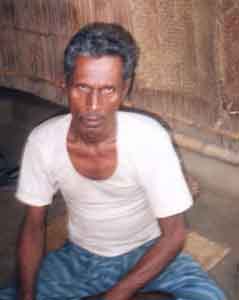 Naranyan Sheel |
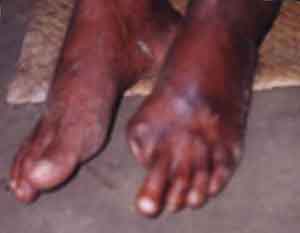 Foot of Naranyan Sheel |
The pictures of Narayan Chandra Shiel of Dhakin Tepakhola Colony, Faridpur is now shown all over the world. He was about to die but after treatment in India he has slightly recovered. Three members of the family are also seriously sick. He is a barber but can hardly work. He gets fever, his finger trembles. They have spent all their savings. Narayan Shiel with wet eyes said “ We have lost everything. Possibly, I would have died, if my wife had not taken me to Calcutta. Many experts came here but we did not get any thing. Can you please test two water samples for me? I go to work, when I feel little better, but sometimes my hands tremble. Once I cut an ear of a client. Now, who’ll come to me?“ He could not talk further. He looked at the well that poisoned them. Some one was taking some water. A woman who knows this water is poisonous said, „From time to time we drink water from here. We are poor and this is our fate.“
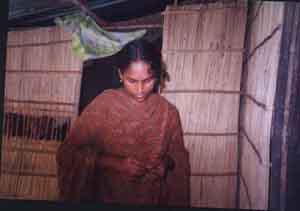
Shakti
A new well was dug at Mohammed Shafi’s house under arsenic mitigation programme and was recommended to drink. I found this water 40 times higher than WHO standard. The family and others were drinking this water as it was certified to be safe. Shakti (Photo), an eighteen-year shy girl is suffering from arsenic disease and socially isolated. She often gets seriously sick - cannot get out of bed. When she was in the school (Class 8) she got arsenic lesion all over her body and friends never visited her. It was raining, as if nothing has changed. All of a sudden Shakti’s voice disappeared. She started crying. She heard from the doctor (Dhaka Community Hospital) that may be her case was too late. The vitamin tablets that she obtained are almost consumed. I do not know whether she is suffering from liver cirociss. It is financially impossible for her to go to Dhaka. All they need is arsenic free water. Now city tap water is also above Bangladesh standard. When I asked, „What is her wish?“ In a whispering crying voice she replied, „I wish no one suffers like me.“
In another house we met Mubarak whose brother Shahid died because of drinking water from tube wells that still pour the same poisonous water. They started drinking water from the nearby mosque, thinking water from god’s house but it also contains arsenic at dangerous level. Mubarak is now suffering from liver cirrhosis, which can hardly work at his rickshaw repair shop. They spent all their savings for Shahid to be educated and work in an office. Mubarak’s eyes were shining, when he said, „Our pride was my brother who passed B.A. degree but he is no more with us. He had also liver cirrhosis and had a very painful death.“ Mubrak’s mother is an old woman with arsenic lesions all over the body and in a crying voice said, „My Bajan (Father) has left and now Mubarak has the same disease. I cannot tolerate any more. Why god has punished me? I wanted that my sons bury me and now I have to bury my young boys.“ I cannot write or describe her painful words. It struck me like rains of bullet, when I think; these people could have been saved, if the mitigation could have been for the people and by the people.
Millions of population in Bangladesh is facing the same situation like Shakti, Mubarak, Alam and many others I met.
top of the pageDutch Aid - New Water Supply with Arsenic at Faridpur
Very recently tap water supplied from Faridpur Pouroshava designed and approved by the consultants of Dutch Aid. It was very well known that deep wells at Faridpur are highly arsenic contaminated, but no design or effort was made to remove completely arsenic and disposal of arsenic sludge. But this water also contains arsenic higher than Bangladesh standard (0.05 mg/l). This water is also bad for Narayan Shiel. According to Bangladesh water standard this water should be in red (banned - not for use). Faridpur Water Supply can easily improve this water by adding Ferrous Sulphate.
Paradoxically every morning the sand filters are back washed and arsenic sludge is disposed of in the nearby Kumar River without any treatment (Photo). The slums that live close to it have no access to tap water but the highly contaminated tube well water that contains 0.40-mg/l arsenic. The close Kumar River and surrounding surface aquifer are turning to be poisonous with the knowledge of the engineers and scientists of Dutch Aid. Is it possible to do the same in their own country?
top of the pageFirst Costly Unsuccessful Deep Well followed by not Workable Separator
At Dhakin Harishava where Mubarak and six other died of arsenic poisoning, authorities drilled two deep wells under arsenic mitigation programme. But these wells also contain dangerous level of arsenic 1.76 mg/l (WHO standard 0.01 mg/l). I have found most of the areas tube wells are not yet analysed for arsenic. People obtained impressions from NGOs and aid agencies that if water contains iron, it is contaminated. But I found many wells with low iron but contain very high arsenic concentration. All wells at Dhakin Tepakhola ranges at dangerous level of arsenic.
After complaining in several papers the same authority have very recently set an arsenic separator. Such separators have proved to be unsuccessful in other areas due to clogging, growth of bacteria within the filter etc. It is not understandable why the mitigation authority after contaminating deep aquifer are installing expensive separator which will require servicing by the engineers that we know will not be successful. The villagers complain that after several requests the Public Health Department told them that the villagers have to change the sand, clear the sludge but they do not have any idea about the complicated mechanics of the sand filter!
top of the pageFailure of Arsenic Stakeholders
We met Aler Khan of Dhakin Tepakhola. He said that his water does not contain iron; taste sweet and about 300 persons drink this water. But after test, it was found to be at dangerous level 0.3 mg/l. We traveled to several remote villages in Faripur district. We found most of the wells are at dangerous level of arsenic. At Majurdi, Boalmari, we found most of the wells at dangerous level of arsenic but none of the stakeholders ever visited this area. It is repeated all over the country. In Faridpur district we could not found a single well coloured in red or green. While taking classes with the school students from class eight to ten, I found most of the students do not know about arsenic poisoning in Bangladesh.
Many shifted their well at a different place but all contain almost the same amount of arsenic in water. At Vasan Dankga, Faridpur a tube well (owner, Md. Zakir Hossain) was recommended for drinking by the World Mission, but I found it to contain 0.5 mg (WHO standard 0.010mg/l) arsenic. At Sadipur almost all wells contain 0.5 mg/l but people do not know that their wells are poisonous. Naznin Akhter of village Ambikapur told me that the members of World Mission would obtain deep tube wells although all deep aquifers of Faridpur are arsenic contaminated!
In Bangladesh till today there is no prescribed standard method of water sample collection and analysis. Water sample should be acidified to Ph 2 for arsenic analysis, if not the result will be wrong. I found no drinkable water in many areas although NGOs and Public Health have recommended these wells. NGOs and others working with arsenic mitigation needs to be trained and educated, if we want a successful mitigation program.
top of the pageArsenic Sludge Disposal
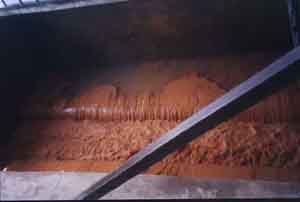
Dutch aided water supply backwashing arsenic sludge
| Water supplies of all contaminated areas of Bangladesh dispose of highly toxic arsenic sludge to rivers or nearby pond. The old units also dispose of arsenic sludge to nearby waterways contaminating surrounding areas. This possibly made Faridpur Sadar as one of the worst affected areas of Bangladesh. Average arsenic concentration in Faridpur is about 0.300 mg/l (300 times higher than WHO standard). Also highly educated laboratories of Bangladesh dispose of toxic chemicals, biological contaminated wastes, and arsenic water disposes into cities sewage system. How can you expect a disposal programme in rural areas? | 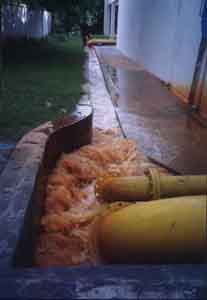 Arsenic sludge disposal |
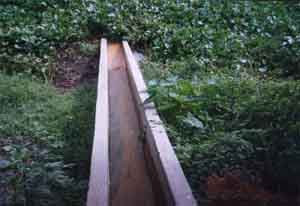
Arsenic sludge disposal to river
Tube Well Bonanza
While visiting affected areas many people came with water samples requesting to test newly constructed tube wells. The tube well companies all over the country gave impression that they know of „a layer, which does not contain arsenic.“ Believing this the innocent villagers set their tube wells at a different place. Abul Karim Khan of Vagan Bhanga brought a newly installed tube well, which contains 0.50-mg/l arsenic (50 times higher than WHO standard).
top of the pageBritish Raj and Deep tube Wells
The British Geological Survey (BGS), the UK's most prestigious hydrology centre, carried out studies on behalf of Bangladeshi Government in the mid-1980s and early-1990s, more than six years before arsenic was shown to be the cause of the mysterious illnesses affecting millions of people. S. Connor and F. Pearce (19.01.01) describe in the Independent News, U.K, "British scientists failed to detect dangerous levels of arsenic in the supply of drinking water implicated in the biggest mass poisoning in history. Two studies of groundwater quality in Bangladesh carried out by British hydrologists failed to monitor natural arsenic levels even though the testing was suggested in voluntary guidelines drawn up by the World Health Organisation. If one really wanted to be charitable to the BGS, you'd excuse them for not finding it the first time, but failing to look a second time appears to be inexcusable." Surprisingly the British Geological Survey did not work with Bangladesh Geological Survey on geological investigations.
More dangerous is their recommendation for deep tube wells, as they reported, “Available data shows that aquifers deeper than 150 - 200 m are essentially arsenic-free over much of Bangladesh. Systematic sampling under the project “Ground Water Studies for Arsenic Contamination in Bangladesh” showed only 2 out of 280 wells deeper than 200 meter to be contaminated (BGS, MML UK, 1998).”
Donor aided arsenic mitigation projects installed several hundreds of deep tube wells at rich man’s houses. Deep well is only successful in the southern districts of Bangladesh, where upper contaminated aquifer is separated by several meters of clay layers. But saline intrusion may displace the whole mitigation programme.
Local contractors are happy to install a well at a cost of 50-100 thousand Takas on conventional method without protecting upper contaminated aquifers. UNICEF has allocated 2 million dollars to DPHE for installation of some 5,500 water points such as deep tube wells (Lockwood, UN Resident Co-coordinator, Feb 27-28, 1999). Such drilling has now contaminated most of the deep aquifers of Faridpur, Kustia and other northern districts. In their own countries construction of deep wells on contaminated water is strictly prohibited.
On 18th July 2001 news on national TV announced successful completion of several hundreds of deep tube wells. Now, who will be responsible for contaminating deep aquifers?
top of the pageKnockout Tournament
There are several methods that have been applied in Bangladesh but these methods did not reach the people. Several of the methods are inadequate, expensive and after treatment and filtration waterborne pathogen become present in water. Different suggested water options are:
While Shakti, Muberak and millions of other arsenic patients drinking arsenic contaminated water most of the companies or NGOs are in race to make the business in Bangladesh. These household or community based separators are not used in their own countries. But DFID (Department of International Development UK) engaged WS-Atkins (UK based consulting firm). Now WS-Atkin, UK in collaboration with BAMWSP (Bangladesh Arsenic Mitigation and Water Supply Project) is recommending Alcan, Steven Technology for Arsenic Removal etc. as appropriate technology for Bangladesh.
top of the pageAlcan and others
Technology of Alcan is based on aluminium. But use of aluminium is a grave health concern. The neurotoxin effects of aluminium first appeared during the 1940s, when it was observed that direct application to the cortex of monkeys produced convulsions with recurrent seizures (Kopeloff et al., 1947). Several other studies followed all noting that the central nervous system of rabbits, cats, dogs and ferrets was vulnerable to aluminium, reacting with seizures, neuro fibrillary change, and epilepsy. In 1987 Norwegian researchers pointed to a statistical link between areas with high aluminium in drinking water and Alzheimer disease. Brown (1989) correlated Alzheimer disease with aluminium levels in drinking water in England:
Aluminium concentration in natural water in Bangladesh is quite high. Peuraniemi, Institue of Geosciences and Astronomy, University of Oulu, Finland found aluminium concentration in investigated areas of Bangladesh notably higher than typical values worldwide. Aluminium concentrations in all surface waters greatly exceed that of WHO (1996) drinking water standards (200 µg/l) in all areas studied (Islam, et al., 2000).
There are an increasing number of studies pointing to a pathogenic role of aluminium in the onset of Alzheimer's disease. Aluminium accumulates in the nucleus of tangle-bearing neurones in-patients with Alzheimer's disease (Perl and Good, 1988).
The primary source of aluminium in drinking water is alum and therefore it is recommended in the industrial countries to reduce use of alum and conventional filtration is also effective.
In industrial countries average 2 L water are consumed daily that is 20-45 mg aluminium intake occurs in a 70-kg reference man. The drinking water guideline of 0.05 mg/l for aluminium is used. Now in western countries with the rise of health consciousness the water supplies rarely use aluminium as coagulant. The normal water of Bangladesh is high in aluminium and after treatment with activated aluminium the aluminium content will raise dramatically, replacing one poison with other. Activated Aluminium is highly selective towards As (V), and this strong attraction results in regeneration problem, possibly resulting in 5 to 10 percent loss of adsorptive capacity (US, EPA, 1999). The activated aluminium has to be imported and the initial cost is very high (Tk. 15,000 per unit) which needed to be changed after every 120, 000 litres. The replacement cost is Tk. 10, 000 (BRAC, 2000). The company has cleverly placed several version of separator. There is no disposal programme, which means it will contaminate with aluminium and arsenic the surrounding environment. Why arsenic contaminated areas in Bangladesh should use the same costly technology as used in South Eastern Dakota and elsewhere in the USA if cheaper and as effective and user friendly measures are available?
Steven Technology for Arsenic Removal is based on coagulation and filtration, where they add iron salt (iron sulphate or iron chloride) as coagulator with oxidising agent bleaching powder. Doses need to be optimised on the basis of water analysis. This secret packing has to be imported and rural population has to depend on suppliers and local agents. Besides chlorination can pose additional problems as it may produce THM (Trihalomethanes), which is carcinogen.
BAMWSP (Bangladesh Arsenic Mitigation and Water Supply Project) has approved such inappropriate technologies for Bangladesh. It is easy to manipulate simple-minded people of Bangladesh. Since it is a question of life and death and the very existence of our future generation all concerned should take the above seriously and take correct and appropriate decisions from the start and formulate national arsenic mitigation guidelines which will ensure effective, less expensive, user friendly and less polluting technology.
top of the pageOpen Dug Holes: An Easy Alternative to Obtain Arsenic Free Water
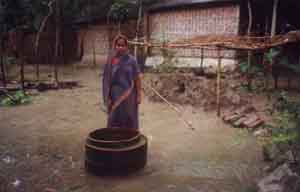
Tarra is proud of her dugwell
Since 1993 arsenic contamination has been detected in Bangladesh. The poor rural population did not obtain any real support or advice in obtaining arsenic free water. Enough money has been spent in arranging seminars, expensive filters (which clogs and is socially unaccepted etc.), replacing arsenic with hazardous chemicals, deep water wells for the rich, while the poor continue to drink arsenic contaminated water. I have travelled to numerous villages in Bangladesh and found dug holes (Kua) not in use but does not contain arsenic.
Our studies show that dug wells do not contain arsenic (very low), where as neighbouring tube wells contain extremely high amount of arsenic in water. "Dug well" is an indigenous technology and its social acceptance is very high and can be constructed with local available sources. It is significant to find how wise our ancestors were when they made dug wells (Kua). In the USA section 265.91 of Code of Federal Registration (CFR) require special design criteria casing, clay packing etc. while sinking wells in a contaminated region. While constructing a “Kua” requires double casing made of terra cotta clay rings where inside is filled with clay to inhibit water percolation from the surrounding geological formation.
top of the pageDug Wells are almost Arsenic free but hand tube wells are highly contaminated
Arsenic and iron concentration in dug-wells and closest hand tube wells (distance of hand tube wells are approx. 10-20m from dug-well)
| Sl. No. | Depth of dug well Meter | Depth of tube well meter | Allowable Standard µg/l | Conc.of As in dugwell (µg/l) | Conc of As tubewell (µg/l) |
| 1 | 15 | 21 | 50 | 6 | 125 |
| 2 | 15 | 15.7 | 50 | 7 | 600 |
| 3 | 10.6 | 33 | 50 | <3 | 300 |
| 4 | 15 | 18 | 50 | 5 | 719 |
| 5 | 12 | 33 | 50 | 5 | 302 |
| 6 | 12 | 18 | 50 | 6 | 468 |
| 7 | 10.6 | 27 | 50 | 6.7 | 218 |
Pathogen, bacteria, viruses can be removed through solar radiation (at no cost) and other methods at site which is acceptable to all. It is easy to remove bacteria. But present experiences in Bangladesh and India show that household methods of arsenic removal have totally failed but donors and NGOs ("more monitoring is required for these filters before it can be recommended") are continuing to support the ineffective methods.
The construction of dug wells that existed even 30 years ago have almost vanished from the country due to non-use and popularisation of tube wells. Advantages of dug wells are:
Dug wells are indigenous technology in Bangladesh.
The wells are cheaper and easier to construct and less susceptible to bacteriological contamination (BRAC, August 2000).
Natural biological filtration occur, when water percolates through sand bodies (develop microbial flora whose metabolism contributes to the effectiveness of removing effluents)
In dug wells within the standing water simple sedimentation take place and has been found frequently a substantial reduction in BOD (Biological Oxygen Demand).
Natural iron coagulation and settlement occur within standing water (decrease in arsenic, suspended solids, ammonia, nitrate and phosphate content).
Protected dug wells provide acceptable bacteriological quality but usual investigation and monitoring methods are inadequate in Bangladesh.
Scientific Studies on Dug Wells (New)
top of the pageSurface Water Irrigation
Agriculture through contaminated ground water is now contaminating our food chain. There is no programme to go back to traditional method of agriculture. Government has no programme on “flood water” irrigation. Wilcock, an irrigation expert, who visited Bengal in early 19th Century, was overwhelmed to see irrigation system in Bengal. He expressed, “river water in the early months of the flood is gold”. 2.5 billion tonnes of fertile soil carried by the Ganges-Brahmaputra Rivers goes directly to the Bay of Bengal.” Flood irrigation system is the only alternative. It will not only stop contaminating food chain and surface water but also reduce use of fertiliser. As we notice after each severe flood, a bumper crop in Bangladesh is recorded.
top of the pageConclusion
Arsenic problem in Bangladesh should be solved within our traditional wisdom. We have suffered a lot from ill advise from outside. Herb Klein, a former US Congress man (July, 1998) expressed, “Much is already clear and it is deeply embarrassing for western scientists and engineers for this crisis is entirely due to their failures.”
We do not want the same mistakes repeating in the name of mitigation. We were united during our independence, severe cyclones, floods and severe tidal storms. Now there is a greater need to be united and fight together for arsenic free water.
It repeats in my ear again and again. Shakti, Mubarak, Shaid and many other arsenic patients, “All we want is that other does not suffer as we do.”
Acute drinking water crisis in Jessore
An acute crisis of safe drinking water is persisting in different parts of Jessore district. Most of the tube wells of the district have turned inoperative since April 5, triggering the crisis, sources said.The Department of Public Health Engineering (DPHE) sources said that the first layer of the water below the ground level is 26 feet which rose by 14 feet during the rainy season. Lifting of water is possible up to 26 feet. But if it falls below the layer, then the shallow tube wells and hand driver tube wells go out of operation.
According to the sources, at present the water level in these areas has fallen below 20 feet and it is likely to fall further. It is gathered from different sources that drawing of water with the hand driven tube wells has become almost difficult. The official source, however, disclosed that the dry season in these areas started from April and May. The rate of fall in the water level in the month of June-July next will increase. The people of rural areas as well as pourasabhas are dependent on hand-driven tube wells for drinking water. Further the DPHE sources said about 21,5000 hand-driven tube wells are lying out of order in the eight upazilas of Jessore at the moment. The waters of these tube wells are found arsenic contaminated.
There are 3,752 tube wells in Sadar upazila, 2,185 in Abhoynagor, 1,788 in Bagerpara, 3,819 in Monirampur, 2,338 in Keshabpur, 3,068 in Jhikorgachha, 2,515 in Sarsha and 2,084 in Chowgachha upazilas. A good number of tube wells are found arsenic contaminated. Besides, there are 300 hand-propelled deep tube wells in the district. There are 32 deep tube wells Monirampur, 62 in Keshabpur, 30 in Jhikorgachha and 30 in Sarsha. There are 28 hand-driven Tar pumps in the district. Of which 16 are in Sadar and 12 in Sarsha. The tube wells are used for supply of drinking water.
Last year, a good member of deep tube wells and Tara pumps were installed in the arsenic affected areas of the district for drawing water with 100 feet and 70 feet pipes respectively. A DPHE source told this corespondent that lifting of water with 21,531 hand-driven tube wells would be difficult in the current season. It is apprehended that there would be an acute scarcity of drinking water in the district. It may be mentioned here that the authority should install more deep tube wells which should be connected with electricity to ensure supply of drinking water in rural areas of the district (The Independent, May 26, 2005)..
JICA conducted a study on groundwater development in the country’s three western districts - Jessore, Jhenaidah and Chuadanga- for two years from 1999, which revealed that arsenic contamination in shallow aquifers would spread down into deep aquifers where there was no thick clay layers. The study also pointed out the importance of locating a thick impermeable stratum before sinking of deep tubewells.
On arsenic problems
Water is one of the most vital renewable natural resources and an essential requirement of life. Its ecological importance is obvious. The wetland directly or indirectly has an enormous ecological, economic, commercial and socio-economic importance and values. Such lands contain very rich components of bio-diversity.
According to the BIRI officials Bangladesh receives plenty of surface water from catchments area outside and within and rainfall during June to October. As a result, groundwater is fully recharged during this period of the year except a few locations. The recharged water body is used subsequently for irrigating dry season crops and for household purpose. Rainfall during November to April/May is scanty and surface water unavailability is also a problem as most of the smaller rivers and low-lying areas become dry during this period of the year. Therefore, groundwater is the main source of irrigation in dry season and drinking water in Bangladesh. At present about 3.2 million hectares (ha) of land is irrigated with groundwater which is more than 70 per cent of the total irrigated area and contributes significantly to the country's food grain production.
But the groundwater in some areas of 60 out of 64 districts in Bangladesh is contaminated by arsenic (As). High concentration of As are found in water from thousands of wells across the country and more areas are being identified as contaminated with arsenic. About 30 out of 130 million people are at risk, therefore, this is an issue of major concern to the nation. Long-term use of As contaminated irrigation water or growing crops in arsenic rich soil may lead to crop yield losses and elevated As concentrations in cereals, vegetables and other agricultural products. Therefore, a study was conducted to assess the arsenic concentration of groundwater and its variation over time and place.
Besides "The province of West Bengal, one of the constituent states in eastern India, though located in the lower reaches of the three trans-boundary rivers namely the Ganges, Brahmputra and Meghna (the latter two rivers do not flow through West Bengal) is no exception from water induced stress and has been confronting various problems related to water resource for quite some time. West Bengal has a vast area under wetlands. The over all production and economic outturn of the system is not at all encouraging due to its ill adaptation with the system, economical setback and technical know how that acquainted at its root level. The main sources of water to wetlands are precipitation, groundwater and surface flow. The amplitude and frequency of water level fluctuation control the characteristics of wetlands.
India is fairly rich in water resource but judicious water use considering quality of water is crucial to sustainable development of wetlands. The issues like misused and wastage of developed water resources, groundwater deterioration, growing menace of flooding and wetlands, increasing scarcity of quality fresh water can be considered for more productive wetlands.. The strategies such as management of excess water and production system in hydromorphic environment, protection of environment from water pollution hazards, multiple use of water, management of water available in lower order streams in high rainfall areas. To develop reliable database on water resource availability and the status of wetlands utilisation, which may be of practical utility if proper implementation of the strategies in appropriate time and places will increase the productivity of wetland areas in a sustainable manner.
Water is probably the most critical element for all living beings in this planet. In the rural villages of Bangladesh, access to safe and clean water is still considered a privilege that only a few people can enjoy. The rural poor generally depend on rivers, canals, or ponds to meet their day-to-day need for water. These sources are often not available during the dry season. Recently with the widespread arsenic contamination in the ground water, the existing tubewells are now considered useless. As a result, availability and accessibility of clean and safe drinking and cooking water now is a dream for the majority of the rural poor. These rural poor are mostly small and marginal farmers and they comprise the largest section of the country's population. To provide easy access to water to this marginal community, after this new ground water contamination, has become extremely urgent to save the lives of millions of men, women and children.
Unfortunately to the enlightened people - the scientists, the water experts, the government as well as the donors, this still remains an academic debate and a giant jigsaw puzzle to solve and address this, while, every day, every hour, every minute, millions of helpless children, women and men are drinking poison and slowly drifting to complex health problems. While we still continue to engage ourselves in another academic discussion, probably hundreds of newborn babies in the rural areas are forced to drink poison water, said concerned officials. Although, we now know that, a large number of working technologies have been invented all over the world which can either treat arsenic water to provide easy access to safe drinking water to the community, we would probably need another one decade of discussion and debate to identify the most effective mechanism to distribute and teach these rural households to effectively use these new technologies.
The effective delivery of the technologies would be as challenging as developing a new technology. One can imagine that how extremely slow and lively these academic discussions can become. If we all today do not start the painful slow process of identifying the effective delivery of the technologies, the lively discussions on technologies would be truly meaningless.
Since the civilisation man has adjusted to various forms of hazards and fought against various diseases because of the relationship between social conditions and factors that influence health and the development of disease. Particular societies tended to view these health hazards from the perspective of their own particular culture. As a result an awareness of the social aetiology of disease dawned through common sense and practical experience. A most significant development occurred in the field of public health when it was accepted that uncontaminated food, water, and air as well as sanitary living conditions could reduce the onset and spread of communicable diseases.
As medicines moves into the twenty-first century, it is increasingly emphasised on water, and waterborne diseases. These were given priority to improve the health status of population. It is estimated that at present 11 crore of people in India who constitute 18% of the world's population do not have access to safe adequate drinking water facilities.
Another epidemiological situation is ahead that cholera, plague along with skin diseases, cancer is the - manifestation syndrome while water availability per capita was over 5000 cubic meter per annum in 1950. It is around 2000 cubic meter per annum and the projected availability in 2025 is 1500 cubic meter per annum. Not only geogenic chemical contaminants in groundwater and increasing pollution owing to industrial activities have brought about the crisis in water availability but also the management policy. Preserving the quality of water and ensuring its availability on sustainable basis are now-a-day major challenges in Bengal basins of West Bengal and Bangladesh. The excess of naturally occurring harmful inorganics like arsenic and fluoride in ground water is a major health concern in a umber of Asian countries like India, Bangladesh, China, Taiwan, Thailand, Myanmar. Nepal, Vietnam, etcetra. Almost 50 to 100 million people in these countries are at the risk of drinking water with arsenic concentrations above 50 microgram per litre.
The same figure for West Bengal in India would be between 5 to 10 million. 2 to 3 million TWS in India and Bangladesh are likely to be contaminated. The commonly reported symptoms of chronic Arsenic poisoning include hyper pigmentation, dipigmentation and keratosis. Skin cancer and internal cancer can also occur. It is estimated that 0.29 per cent of the population (or 375,000 people) in Bangladesh are at risk of excess lifetime skin cancer at the present arsenic contamination level. Though there have been localised causes of arsenic contamination due to anthropogenic factors like dumping of industrial waste, containing high amount of arsenic, the present crisis in the Indian Sub-continent is due to geo-morphological reasons. Though many attribute the cause of arsenic concentration to the profligate use of ground water to support the "Green Revolution" since the 1960s, there is no scientific evidence so far to support the theory. Though switching over from rain-fed cultivation to four-crop cycle with irrigation facility, supported by shallow bore wells had definitely disturbed the water table and ground water quality.
Informing people about the risk and the status of their drinking water sources is a fundamental responsibility of all sector partners. Lack of proper infrastructure, testing facilities has posed a challenge for developing a comprehensive water quality Surveillance system and a village - specific database. Restrict the people from drinking Arsenic - contaminated water. Other urgent measures include: providing alternate sources of Arsenic free safe drinking water, and medical relief, by way of training medical practitioners both in public and private sectors.
The people and Media must have easy access to scientific information. But under no circumstances scientific information should be used for creating unnecessary panic among the people. With a significant proportion of the population of West Bengal and Bangladesh in extreme social and economic deprivation, competing environmental Health Risk exists in the society. Without diluting the gravity of the situation it must be emphasised that we need to be objective and realistic in making political and economic decisions in relation to the current problem of Arsenic Fluoride Contamination of Ground Water (The Independent, 2005).
Arsenic in Bangladesh:Women suffer more from arsenic contamination in Bangladesh than men do
Rahela (not real name), 30, is yet to start her marital life as she has been suffering from arsenicosis. The woman, a resident of Babutipara village under Muradnagar upazila of Comilla, has been suffering from the disease for the last 12 years.
Now she faces problems to walk and for the last four years her condition has deteriorated. Her elder brother was also suffering from the disease as he drinks water from tube-well, which is affected by arsenic. A Dhaka based NGO working in the village identified them as arsenicosis patients. A test conducted at the Dhaka laboratory of world Health organisation (WHO) also confirmed the disease. Rahela's eyes always remain reddish and she complains of severe stomach-ache. Occasionally she visits upazila health complex for treatment, but her problem is yet to be solved. Her poor father could not be able to bear the expenses for her treatment.
Her brother, who is also an arsenicosis patient, was preparing for getting married, but later the bride's family turned down his proposal for marriage when they came to know that the groom was affected by arsenicosis.
Muradnagar upazila health officials said that many other Babutipara residents have been affected by arsenic contamination. About 98 percent tube-well of Babutipara is contaminated with arsenic, they said. Rehela is not the only woman to suffer from arsenicosis. Another woman, Shahida Begum, 37, wife of Abdur Razzak, of Samta village in Sarsha upazila of Jessore died of arsenicosis on February 26 this year. Her disease was diagnosed in 1996.
The presence of arsenic in ground water has posed a great health hazard and also causing adverse impact on people's health, social and economic activities in Bangladesh, sources at Arsenic Mitigation Water Supply Project said.
The experts in the nineties detected the presence of arsenic in ground water of the country's south-western region. Many experts suspect that the contamination remained undetected due to lack of studies. According to Bangladesh Arsenic Mitigation Water Supply Project (BAMWSP), there are about 38,000 arsenicosis patients people in 61 out of 64 districts in the country and most of the victims are women.
Arsenic causes a number of diseases, including kidney failure and cancer. A study by NGO Forum for Drinking Water Supply and Sanitation said arsenic poisoning could also cause miscarriage and prenatal deaths. Arsenic contamination causes social problems for female victims.
Nari Grantha Prabantana, an NGO, recently conducted a survey on 1,200 people at 15 villages of Chapainawabganj and Pabna districts. It reveals that female arsenicosis victims suffer more from social stigma than their male counterparts.
It said problems created from arsenic contamination have increased the prospective groom's demand for dowry to marry arsenic affected girls. There are also cases of divorcing arsenic-affected wives. In view of increasing arsenicosis patients, the government has initiated a national programme to address the affects of arsenic (BSS/UNICEF Feature, 2005).
Arsenic menace spreading its tentacles in Madaripur
May 16, 2005 : Arsenic menace is spreading its tentacles in Madaripur district. It is gathered from a competent source that about 50,000 people of Rajoir, Shibchar, Sadar and Kalkini upazilas of the district have been affected by arsenic contamination for drinking waters of shallow tube-wells for a long time. At least seven persons died of arsenic-related diseases (arsenicosis) during the last one year, it is learnt.
The dead were identified as Rabeya Begum (30) of Apashi village, Eklas Bepari (35) of Datter Hat, Shefali Begum (38), Jahanara Begum (30), Mizan Bepari (22), Zakir Hossain (28) and Mukul (9) of Datter Hat village in Sadar upazila of the district. At least 410 persons have been suffering from arsenic-related diseases in the four upazilas. A Non-Government Organisation (NGO) Ankur with the help of NGO Forum found 190 people affected by arsenic contamination in Apashi and Datterhat villages in Madaripur Sadar upazila.
The water of most of the tube wells is arsenic contaminated. A source in the Department of Public Health Engineering (DPHE) said that about 455 shallow tube wells have been lying out of order in the district. These are 150 in Kalkini, 75 in Rajoir, 142 in Shibchar and 88 in Sadar upazilas. The number of shallow tube wells installed by the government in the district is 10,876. A total of 3,336 are in Shibchar, 2,777 in Sadar, 2,670, in Kalkini and 2,093 in Rajoir upazilas. According to government sources the number of tube wells that went out of order is 545 but the number is more than 1,000, according to the unofficial estimate.
The DPHE authority stopped installation of shallow tube wells after the financial year of 1996-97. The number of tube wells lying out of order is increasing. The department after testing water of 3,092 tube wells found arsenic contamination above 0.05 mg in the water of 849 tube wells.
top of the page7 Wards in Ctg City Arsenic level way beyond limit
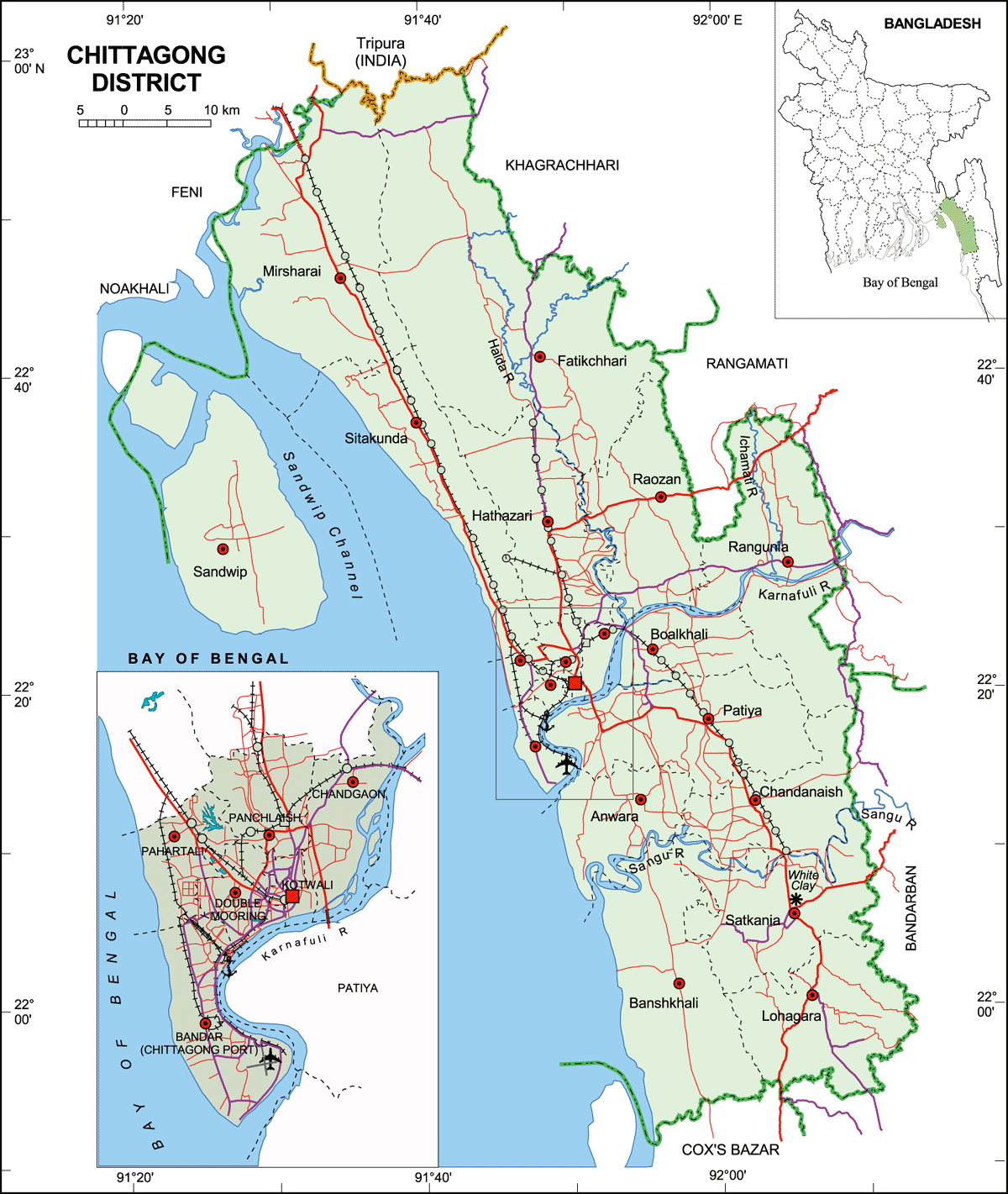
CCC and other authorities have so far taken no initiative to protect the endangered population, alleged local residents.
CCC and Public Health Engineering Department (PHED) are rather pointing fingers at each other, saying it is the other's duty to detect and seal the contaminated tubewells.
Users of those tubewells do not even know that they are being exposed to high levels of arsenic.
The findings were revealed by a recent survey jointly conducted by the Chittagong University of Engineering and Technology (Cuet), and the Institute of Engineers of Bangladesh, Chittagong.
The seven affected wards are East Sholoshahar, South Kattali, West Bakalia, East Bakalia, South Bakalia, North Agrabad, and North Halishahar.
According to World Health Organisation (WHO), 0.05 ppm (part per million) arsenic in water is safe for human body.
But tubewells in North Halishahar and East Sholoshahar are pumping water that contains 0.5 ppm arsenic, 10 times higher than the safe level.
Dr Swapan Kumar Palit of the civil engineering department at Cuet said the seven wards have been identified as more risky. His department has done a detailed survey in East Sholoshahar recently.
Of the 233 tubewells in ward 6 of East Sholoshahar, 99 pump water with high levels of arsenic, said Dr Swapan, who is the key researcher in the survey.
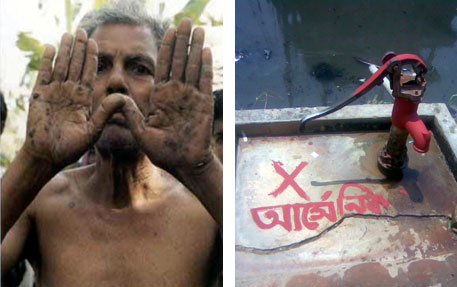 Areas affected by the highest level of arsenic in the ward are Baraypara, Ghasia Para, Chairman Ghata, and Omar Ali Matabbar Road, Swapan said adding that generally low-income group people and slum dwellers live in these areas with no water supply from the Water and Sewerage Authority (WASA) (Pranabesh Chakraborty, Daily Star, April 2, 2012),
Areas affected by the highest level of arsenic in the ward are Baraypara, Ghasia Para, Chairman Ghata, and Omar Ali Matabbar Road, Swapan said adding that generally low-income group people and slum dwellers live in these areas with no water supply from the Water and Sewerage Authority (WASA) (Pranabesh Chakraborty, Daily Star, April 2, 2012),
Dr. Karim writes: In 1980s arsenic level was very high and shallow tube well project from WHO/UN had made arsenic poisoning in Bangladesh in millions. That hasn't been explored to people and hiding game is going about affect of arsenic in Bangladesh yet.
Home
Last modified, April 29, 2013
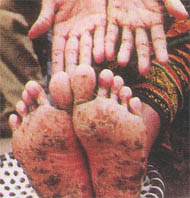 Referring to adjusting data from the United States Environmental Protection Agency (EPA), it said that in Bangladesh with regards to projected future cases of arsenic related health burden, skin cancer would affect 375,000 people. The estimate also suggest that in Bangladesh 6,500 people will die from cancer every year and a total of 326,000 people in a period of 50 years, while 2.5 million people will develop some kind of arsenicosis over that period. So far, these two figures are the only quantification of the potential arsenic related health burden. They depend heavily on epidemiological assumptions and demonstrate how the lack of reliable epidemiology information adds uncertainties to the projected number of people at risk.
Referring to adjusting data from the United States Environmental Protection Agency (EPA), it said that in Bangladesh with regards to projected future cases of arsenic related health burden, skin cancer would affect 375,000 people. The estimate also suggest that in Bangladesh 6,500 people will die from cancer every year and a total of 326,000 people in a period of 50 years, while 2.5 million people will develop some kind of arsenicosis over that period. So far, these two figures are the only quantification of the potential arsenic related health burden. They depend heavily on epidemiological assumptions and demonstrate how the lack of reliable epidemiology information adds uncertainties to the projected number of people at risk.